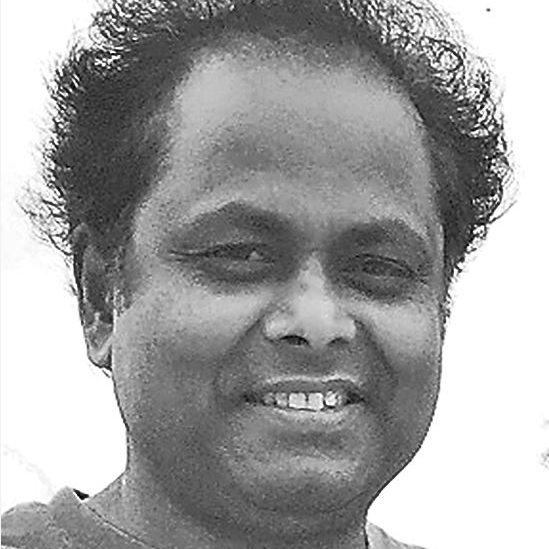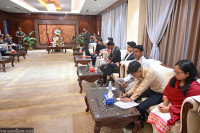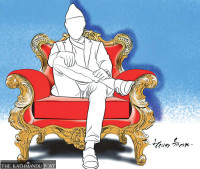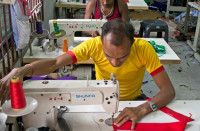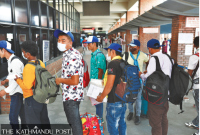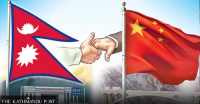Opinion
Shifting identities
There is a need to deconstruct the notions of ‘Nepali’ identity and nationalism
Pramod Mishra
The way out of the present imbroglio starts from the realisation that Nepal’s social formation and geopolitics present enormous complexities even for the most learned of scholars. And to comprehend and lead this complex country in 2015 it would require an equally sophisticated mind and emotional breadth, something akin to that of Jawaharlal Nehru when he wrote The Discovery of India. Does Prime Minister KP Oli and the minds he has gathered around him possess these expansive qualities? So far, it does not look like they do. But one thing is certain—with the composite hill caste nationalist mindset of the last 250 years, especially the last 55 years—they are sure to put their countrymen through untold suffering.
Who is a Nepali?
Shekhar Golcha, the scion of one of Nepal’s leading business houses, wrote a searing Op-Ed in Kantipur a few months ago, asking what else he could do to be a Nepali even as his family, since his grandfather’s generation, had lived and introduced modern business in the country. He was responding to another businessman’s comment that he (the real Nepali) wished there was a Nepali by blood in the Nepali business delegation team in its recent trip to India. The Madhesis of Bhardah complained to journalists that in the August 24 raid in the houses of the village—in which a protester died in police shooting—the Nepal Police and Nepal Armed Police personnel abused men, women and children by calling them ‘Bihari’, ‘Madise’ and ‘Dhoti’ and asked them to go back to where they came from. Over the weekend, security forces subjected Madhesis in Rajbiraj to similar abuse.
Who is a true Nepali has been a burning question since the word ‘Nepali’ came into circulation in Nepal in the second half of the 20th century. For my Rajbanshi grandmother Sodosari in Morang, ‘Nepal’ was Kathmandu Valley even in the late 1960s. She had visited ‘Nepal’ in the late 1950s or early 60s by plane and she never tired talking about it for the luxury she had bestowed on her ex-son-in-law by taking him along with her on the trip but who had now abandoned her daughter. The word ‘Nepali’, too, came into coinage not long ago. As Khas Kura became the Nepali language, people of Khas origin first became Gorkhalis and later, both the groups became ‘Nepali’ with historical evolution. And in the course of the 30-year long Panchayat era, one language, one dress nationalism rooted the word and the concept it denoted. Jung Bahadur’s Muluki Ain codified hierarchies of power and privilege based on his own state-sponsored caste system but it does not define the term Nepali.
So, Nepali is an invented term of recent origin. Theoretically, is not that surprising since Benedict Anderson’s famous conceptualisation of imagined communities. But what needs unpacking is the process and nature of the term’s construction so that we can better understand the past and move forward, break the imbroglio and unshackle Nepal’s citizens from the past baggage of ‘Nepali’ identity and Nepali nationalism. For, an independent, sovereign state or country offers many advantages, besides pride. But the self-serving notion of national identity has excluded the non-hill caste folks of the country called Nepal. Without understanding it fully, it is bound to cause a disaster. Just because ‘Nepali’ is an invented term does not make it harmless. As in the cases of Golcha or the people of Bhardah or Rajbiraj in eastern Nepal or countless others in Nepal’s villages and towns and power centres, the term ‘Nepali’ and the concept it denotes privileges and empowers some while humiliating and excluding others. That is why many major excluded groups are demanding federal states of their own to mitigate their exclusion and co-exist with the 250-year-old, 55-year-muscularly built, Nepali-language, hill caste Nepali identity.
How was the word—taking its origin from the Nepal Valley, which is Kathmandu—emptied of its original connotation of the culture (Newar), people (Newari) and language (Nepal Bhasa) of the Nepal Valley and came to be inhabited by Khas Kura (Khas language), and congealed into daura suruwal and topi sartorial identity out of dozens of different variants of dressing habits even in the hills? Jung Bahadur’s Muluki Ain, by its privileging of the hill Brahmins and Khas Kura-speaking aristocracy may have paved the way. But until the advent of the Panchayat system, even the official language was not common Khas Kura but a special legal lingo with lots of borrowing from the Persian of the Mughal court, special language of shresta.
Deconstruct the concept
The question the Nepali state confronts now is—can it stretch itself by expanding and inserting multiplicity into its national identity the way it shrank in its definition during the Panchayat era or since its inception in the mid-18th century? Can it shed its hang-ups or break its shackles of narrow self-definition and mono identity in which it has imprisoned itself and many inhabitants of the country, especially since 1962? In place of their own ethnic zamindars and zamindari before the advent of the Panchayat system, they want their own chief ministers and provinces with which they can identify themselves or at least feel comfortable with.
These questions have assumed urgency as never before because while the defenders of the concept still have the power to insult the highly-educated cosmopolitan scion of a business house, frighten and humiliate the simple, powerless villagers of Bhardah or discriminate against Nepali women in bestowing citizenship to their children in their own name. Challengers of the concept, too, are marshalling their wits and harnessing their forces.
If you ask me, I would say defend the term Nepali and the state Nepal at any cost but deconstruct and dismantle the concept and disabuse the concept holders at any cost to save the term and the state. Let the garden of the founder bloom in hundreds of colours if you want to save the garden. Else, all inhabitants of the country will face unprecedented suffering and the country will face an uncertain future and risk survival in its present form.




 19.12°C Kathmandu
19.12°C Kathmandu